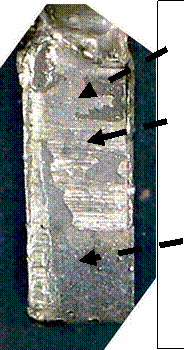Solving Brazing Problems
Analyzing and Solving Brazing Problems- part 1
There are many things that can cause brazing problems to occur. After 30 years of being in the saw blade industry we have seen everything from saw tips falling off, saw tips breaking and even ripped shoulders on saw blades. Many of these issues are due to brazing problems and can be prevented with proper brazing techniques. In this blog series we will address some of the most common causes of brazing failure and how to avoid them. You can also find a more in depth guide on How to braze on our website or in our book Braze Failure Analysis.
Some of the most common causes of brazing problems are:
- Improper cleaning of the parts
- Surface condition of the parts
- Using the wrong braze alloy
- Improper fluxing, improper braze joint thickness
- Brazing at the wrong temperature
- Gas entrapment
- Overheating the parts
- Or a combination things
First we will look at improper cleaning of the material or parts being brazed and surface condition of the parts. We will discuss the rest of the common causes for brazing problems in the next blogs in this series.
Saw plate cleanliness. Saw plate is often oiled to keep it from rusting. This can cause many problems for brazing if the steel is not cleaned well before brazing. Oil and grease left in the notch will contaminate the braze joint and can greatly weaken the bond. There are different kinds of oils and greases. A cleaner that removes one kind may not remove all the others. The notch is usually ground or gummed, and sometimes even sandblasted. If the notch is not cleaned properly prior to brazing there will be sand or diamond particle left in the notch. If the tip comes out you will see a sparkly or glittery appearance. There are many cleaners and techniques you can use to clean saw plate that will remove the oils, grease or dirt left on the plate and in the notch so that they do not contaminate the braze alloy and weaken the braze joint.
Surface condition of the saw tip
Some treatments involve a chemical preparation of the saw tips to clean them and then the plating of a coating or layer on top of the cleaned saw tips. This layer is designed to promote wetting. The problem can occur when chemical preparation to clean the saw tip doesn’t take and the coating is put on top. The braze alloy sticks to the coating which does not stick to the tip. Adding a plating or coating to the top of a cleaned saw tip doesn’t always have a negative effect, it can also add to the strength of the bond to the braze alloy if done correctly.
One treatment used for cleaning saw tips is the ECP process. The ECP process is a process we invented. It leaves the surface entirely free of oils, greases, free carbon and other contaminants. It also leaves the surface etched to an even distance of nine microns, which gives excellent wetting and bonding characteristics. For more information about our Treatments or services Please call us at 1-800-346-8274 or email: Sales@carbideprocessors.com.
There is another process based on a high temperature, salt bath treatment that removes individual tungsten carbide grains and leaves the surface cobalt enhanced. This process has been around thirty years and has a reputation for working well.
There are three possible approaches to get the carbide saw tip to have a strong bond with the Braze alloy.
1. The tungsten carbide may be prepared in such a manner that there is a very rough surface and the solder will flow into the surface holes and bond physically.
2. The tungsten carbide may be prepared chemically so that there are electrons available in the tungsten and the silver solder forms silver tungstate during the pretinning.
3. The tungsten carbide may be activated and then plated with a presolder substance so that the tungsten carbide surface is protected. In this case the braze alloy can react with the top layer of the plating or the plating will dissolve into the braze alloy and the braze alloy will form a bond directly with the solder.
Making sure your saw plate and saw tips are properly cleaned and prepared for brazing may prevent problems with tip loss. We will discuss types of braze alloy and flux, and how using the right type of braze alloy and flux can also solve many of your problems with tip loss and tip breakage in our next blog in this series.
Leave a Reply



